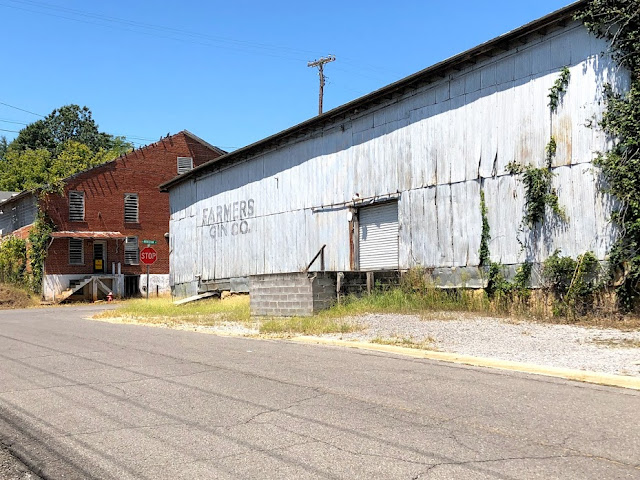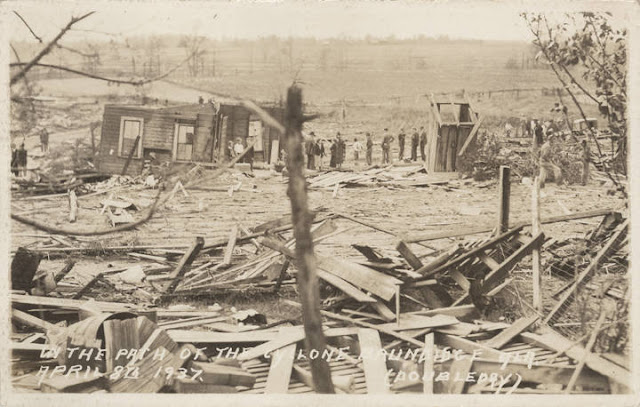Last August my younger brother Richard and I made an abbreviated summer brother trip by visiting Scottsboro, a town neither of us remember ever seeing before. On our way there from mom's house in Huntsville we passed through Owens Cross Roads so we could check out Gibson Books. I've written about that fascinating emporium here.
We arrived in Scottsboro about 4 on a Friday afternoon. You can read part 1 of this post about our visit here. In this one I cover more of Saturday's activities.
We arrived in Scottsboro about 4 on a Friday afternoon. You can read part 1 of this post about our visit here. In this one I cover more of Saturday's activities.
So here is Scottsboro's shopping mecca, the world famous Unclaimed Baggage Center. We left the Scottsboro Boys Museum and drove just down the street to this place. Quite a disconnect, but that's America.
I was underwhelmed, actually. The place is huge, with seeming acres of men's, women's and children's clothing. Then there's the luggage, cameras, winter ski equipment, and just endless stuff. I went through the books section, which consisted mostly of bestselling novels from the past decade or so. I didn't find anything of enough interest to warrant a purchase, but Richard did get a sports coat and a hat. We wondered if they had a back room where the guns, knives, brass knuckles, booze, etc, were for sale....
You can read about the Center's history here and a "how it works" page is here. Since it was a summer Saturday, the place was packed.
Another Scottsboro attraction is the railroad depot and museum. Unfortunately, the museum was closed, so perhaps another day....
The depot was built by the Memphis-Charleston Railroad on a route that ran through such north Alabama towns as Tuscumbia, Decatur and Madison as well as Scottsboro. This building opened in January 1861 as the town's first brick structure.
The Memphis and Charleston had built 272 miles of track between Memphis and Stevenson by May 1857. The first station was a wooden platform with a small building from then until the brick one opened.
This depot served both freight and passengers until a dedicated passenger depot opened in January 1892.
A historical marker can be seen that describes the depot:
The Memphis and Charleston Railroad Company constructed the Scottsboro Railroad Depot in 1860-1861 as a passenger and freight facility. The rail line ran throughout the Confederacy and the Union considered its capture vital to cutting off supplies to the south. On January 8, 1865, the Depot was the site of an intense battle between 101st U.S. Colored Infantry and the 110th U.S. Colored Infantry, who held the Depot, and Confederate soldiers led by Brigadier-General H. B. Lyon. The out-numbered Union soldiers defended the station until Confederate artillery fire drove them from the building. In 1870, newly incorporated Scottsboro designated the Depot as the center point of town when laying out the city limits. With the completion of a new building in 1891, the Depot stopped handling passenger traffic. The Depot remained important in the economic and social activity of the city until the 1960's. The Depot is one of only three remaining pre-Civil War railroad depots in the State of Alabama.
Listed on the National Register of Historic Places in 1998
Listed on the National Register of Historic Places in 1998
As noted on the marker texts above and below, on January 8, 1865, Union defenders and Confederate attackers skirmished at the depot. Cannonball and other damage is still visible.
The depot is the oldest existing business structure in Jackson County, and one of only three pre-Civil War depots still standing in Alabama.
I failed to take a photo of side 1 of the marker below, but here's the text:
In late December 1863, Union Maj. Gen. John A. Logan established his Fifteenth Army Corps headquarters in Scottsboro, Alabama. On January 11, 1864, by command of Gen. Logan, Brig. Gen. Hugh Ewing, commanding the Fourth Division, was ordered to guard the railroad and telegraph line from Scottsboro to Stevenson. Gen Ewing sent his First Brigade under the command of Col. Reuben Williams to Scottsboro, and it set up four separate regimental camps on either side of the Memphis and Charleston Railroad, adjacent to or within one block of the Scottsboro Depot. The regiments under Col. Williams’ command included some 3000 men of the 26th Illinois, the 70th Ohio, the 12th Indiana, and the 97th Indiana, as well as an Illinois artillery battery.(Continued on other side)
Near the depot is the abandoned Farmers Gin Company building
Another abandoned building near the depot, formerly the Scottsboro Wholesale Company.
Memorial to Andrew Jackson on the courthouse square
Robert Thomas Scott bought 1240 acres in Jackson County between 1848 and 1858. He established a grist mill and saw mill for residents of the area and a post office called Scott's Mill opened in May 1854. The name of the community was changed to Scottsboro in 1860 and incorporated in 1870 after the county seat was relocated from Bellefonte in the previous year. More details are given on the marker above. The original city limits extended a half mile in all directions from the depot.
On our way back to Huntsville we had lunch here and a pleasant drive along Lake Guntersville.

















































